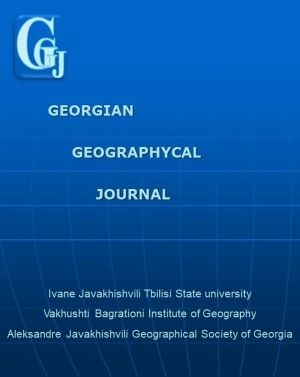Demographic Issues of Social-Economic Development of Eastern Georgia: Population as a Demographic Potential
DOI:
https://doi.org/10.52340/ggj.2022.752Keywords:
Demographic potential, population, child-woman rate, gender-age pyramid, labour force, unemployment rate, share of self-employedAbstract
The policy of stimulating regional development is based on local potential, one of the main components of which is population: its number, nature of reproduction, structure, and social-economic conditions (employment, standard of living, and so on).The present research aimed to study the issues of Georgia's demographic potential: population dynamics, natural movement, migration, gender and age structure, labour force, and standard of living of the population. The study of the demographic potential of Georgia is a long-term task of the authors, the first geographical object of which is the study area of the present article - eastern Georgia and, in particular, the regions of Kakheti, Mtskheta-Mtianeti, Kvemo Kartli (not including Tbilisi, the capital of Georgia, but including self-governing city Rustavi) and Shida Kartli. The research adopts a geographical approach, focusing on a unified vision of the issue, and studies regional differences. The research results outline the demographic situation in the study area and the modern trends that reflect the peculiarities of the demographic potential of eastern Georgia. These include the following: a) the decline in the absolute number of population has slowed down in the last decade due to reduced emigration; b) according to the latest statistics, in eastern Georgia as a whole, natural increase is negative (-0.4 percent), but higher than the national average (-1.1%); c) the process of population ageing in eastern Georgia has been generally outlined, the dynamics of which are different between the regions - in Kvemo Kartli, due to the relatively high natural increase, it is developing relatively slowly than in other regions; d) the share of women in gender structure is reduced (50.9 percent) compared to the country's average rate (52.3 percent), while in Mtskheta-Mtianeti, contrary to the general rule, The share of men exceeds that of women; d) Georgians make up 75 percent of the ethnic structure of the study region, followed by Azerbaijanis (19.7 percent), the principal part of the latter concentrated in Kvemo Kartli, which, in, turn, determines a number of peculiarities of the demographic behaviour of the population in this region; e) a large part of the population of eastern Georgia is mostly employed in traditional, non-commercial and partly commercial agriculture, due to which a higher share of self-employed (41.6 percent) was registered in the study area compared to the average in the country (31.9 percent); f) unemployment (18 percent of the economically active population), low income and low purchasing power remain the main social-economic issues. In the last decade, as in the whole of Georgia, signs of improvement were noted in the social-economic situation in the study area, though the COVID-19 pandemic partially slowed this trend.
Downloads
Metrics
References
Tsitsagi, M. & Kvirkvelia, N. (2019). Some Demographic Trends in Borderline Regions of East Caucasus Mountains (Georgia). Ankara Üniversitesi Çevrebilimleri Dergisi, 7 (2), 125-129. Retrieved from https://dergipark.org.tr/en/pub/aucevrebilim/issue/51058/626462
The EU Delegation to Georgia launches the 2015 campaign on "Let's Greet Europe Together" http://eugeorgia.info/ka/articlefeatured/29/evrokavshiris-warmomadgenlobasaqartveloshi--2015-wlis-kampanias-ertad-shevegebot-evropas-iwyebs--/ Accessed June 25, 2021.
Gachechiladze, R. Population migration in Georgia and its social-economic consequences. Tbilisi, 1997. p. 27 (in Georgian).
Gugushvili, T. (1998). External migration-demographic problems of Georgia. Tbilisi, (in Georgian).
Kekelia, J., Tskhakaia, T., Khabazishvili, M. Territory of Georgia and settlements (cartometric analysis). Tbilisi, Intellect, 2004.
Meladze, G., Tsuladze, G. (1997). Population of Georgia and demographic processes]. Tbilisi. 1997 (in Georgian).
Jaoshvili, V. (1996). Population of Georgia. Tbilisi, p. 160 (in Georgian).
Salukvadze, J., Meladze, G. Georgia: Migration, a Main Risk Towards Sustainable Demographic Future, Discovering Migration Between Visegrad Countries and Eastern Partners. HAS RCAES Geographical Institute. Budapest, Hungary. 2014. pp. 150-169.
Hakkert, R. Population dynamics in Georgia (review based on the results of the 2014 population census). Tbilisi, 2017.
Kvirkvelia, N., & Tsitsagi, M. (2021). Impact of COVID-19 on Tourism in Georgia-An Overview. Georgian Geographical Journal, 1(1). https://doi.org/10.52340/ggj.2021.08.10
Source: 2002 and 2014 population censuses materials of population of Georgia.
https://www.geostat.ge/ka/modules/categories/316/mosakhleoba-da-demografia
Geostat data https://www.geostat.ge/en/modules/categories/552/methodologia-social-statistics
Geostat data https://www.geostat.ge/en/modules/categories/683/Employment-Unemployment
Geostat data https://www.geostat.ge/ka/modules/categories/683/dasakmeba-umushevroba
Geostat data https://www.geostat.ge/regions/
Geostat data https://www.geostat.ge/en/modules/categories/683/Employment-Unemployment
Unemployment in Georgia. Economic Review and Indicators in Georgian (2017-2020).
Labor Market Analysis of Georgia 2020.
Geostat data https://www.geostat.ge/en/modules/categories/39/wages
Geostat data https://www.geostat.ge/en/modules/categories/48/standard-of-livingsubsistence-minimum
Geostat data https://www.geostat.ge/en/modules/categories/53/healthcare-and-social-protection
Downloads
Published
How to Cite
Issue
Section
License
This work is licensed under a CC BY Attribution




